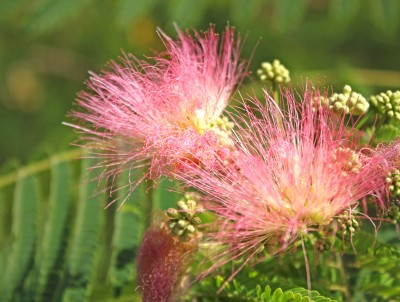Silk Tree - Albizia julibrissin

Common Names: Silk Tree, Mimosa Tree, Persian Silk Tree, Pink Siris, Lenkoran Acacia, Silk Tree Mimosa, Powderpuff Tree, Bastard Tamarind, Night Sleeper, He Huan Hua, Shabkhosb, Nemunoki, Nemurinoki, Nenenoki, Nemu Tree, Mimosa, Albizia, Albizia julibrissin, Global: Persian Silk Tree, Latin: Albizia julibrissin
Latin Name: Albizia julibrissin
Origin: Asia
Short Introduction
This plant requires slightly acidic soil, with a pH between 6.7 and 8.5. Silk Tree enjoys sunny locations and should not be shaded, even at the roots, as it prefers warmth. It is intolerant of waterlogged soil, and fertilization is best applied only during flowering to support blossom development. Choose poorer soils and be cautious with fertilizers, which can trigger excessive, tender growth that is vulnerable to frost damage.
Detailed Description
Silk Tree is renowned for its calming properties, supporting sleep and easing nervous tension by acting on the central nervous system.
Botanical Information
Silk Tree (Albizia julibrissin) is a deciduous tree reaching up to 10 meters tall. Its crown is circular, broad, and dense, with a brown-grey, smooth trunk. Young branches are softly green. Its leaves are bipinnate, featuring semi-circular, beautifully green leaflets paired opposite each other, around fifteen pairs per leaflet. In high temperatures or at night, the leaflets close, earning the plant its nickname 'Sleeping Tree' due to both this behavior and its soothing effects. The sweetly fragrant inflorescence of the Silk Tree is especially striking, with delicate pink flower stalks, though the blooms can sometimes appear dark red. The fruit is a long brown pod containing flat seeds. The tree flowers throughout summer.
Origin and Distribution
Albizia julibrissin originates from Asia. In the latter half of the 18th century, this rare tree was introduced to Europe by the Italian noble Filippo degli Albizzi, after whom the plant is named. Its 'silk' moniker refers to its unique blossom. Today, it is seen in Central Europe, often cultivated in containers, and occasionally in gardens or parks.
Usage / Dosage
Animal studies on mice indicate that high doses of Silk Tree extract exhibit antidepressant effects, likely due to action on serotonin receptors. According to a 2002 epidemiological study, Silk Tree (and preparations containing it) was the third most prescribed herb for insomnia and anxiety in traditional Chinese medicine.
Two studies in rats reported a significant anxiolytic effect of Silk Tree extract, apparently mediated through changes in the serotonergic system, especially via 5-HT1A receptors. Another study found notable improvement in brain monoamine neurotransmitter levels in behavioral tests, indicating anxiolytic activity in chronically stressed rats.
Further research in animals investigated the effect of Silk Tree flower extract on sedative substances. Results showed that the extract (in both a single acute dose and repeated doses) enhanced the anesthetic effect of medications.
Anticancer research focused on the julibrosides J1, J2, and J3, among others. These compounds demonstrated promising effects in suppressing activity and growth of breast, prostate, and cervical cancers. Julibrosides J8 and J13 from the tree's bark, at 100 mcg/mL of ethanol extract, showed cytotoxic activity against liver carcinoma cells. Other substances, such as julibroside J21, exhibited similar properties, and additional derivatives inhibited epidermal cancer cell growth. Julibroside J8 showed inhibitory potential against the growth of gastric cancer cell lines and could induce programmed cell death in cervical cancer cells through caspase activation. In mouse lab experiments, julibroside J8 reduced the size of solid tumors by 16.7%, 35.2%, and 67.5% at doses of 0.5, 1.5, and 3 mg/kg, respectively. Notably, another study documented DNA apoptosis in T-cell fragments from human acute leukemia (again via caspase activation) with the active compound HaBC18.
Studies also describe a growth-inhibiting effect of Silk Tree root extracts against streptomycetes bacteria. Other publications report that the plant halts the proliferation of oral streptococci, as well as showing effects against Bacillus subtilis, Salmonella typhi, and Staphylococcus aureus.
Silk Tree bark extract at doses of 5–10 mg/kg displayed anti-inflammatory activity in ear inflammation models. Dry methanol bark extract demonstrated notable detoxifying effects, attributed to glycosidic flavonoids. Other studies reveal a significant antioxidant effect, particularly against LDL oxidation.
In traditional agricultural areas, Silk Tree serves as feed for livestock and game. Beekeepers plant Silk Tree near apiaries to provide nectar for bees and butterflies.
Traditional Chinese Medicine uses the Silk Tree (He Huan Hua) to clear the heart and calm the spirit. It has a bittersweet taste, neutral characteristics, and is considered nontoxic. In TCM theory, it enters the heart and spleen meridians; the main function is to relieve depression, promote calmness, regulate qi (energy), stimulate appetite, dispel wind to improve vision, and support blood circulation to relieve pain. The primary indications include depression, insomnia, chest tightness, digestive issues, poor appetite, vision problems (due to wind imbalance), back pain, and injuries from falls.
Active Compounds
Around ten published works focus on the analysis of Silk Tree bark, flower, and seed oil constituents. Literature emphasizes the isolation of julibrosides, triterpenoid saponins (and their prosapogenins), which in other research have demonstrated cytotoxicity and the ability to inhibit growth in some cancer cell types. Additional compounds include the phenolic glycosides albibrissinosides A and B, hyperoside, quercitrin, and quercetin. The seeds are rich in free fatty acids (2.54%), predominantly linoleic, then palmitic and oleic acid.
Traditional Dosage
Silk Tree is typically consumed as a decoction once daily by adding 1.5g (about 1 teaspoon) of dried flower to 200ml of water and simmering for about 15 minutes. Add more water as needed.
Warning: No contraindications are known.
